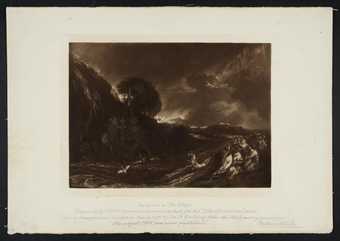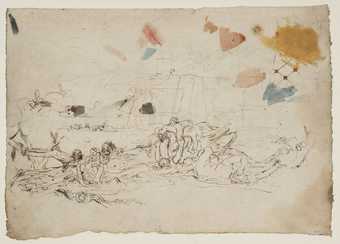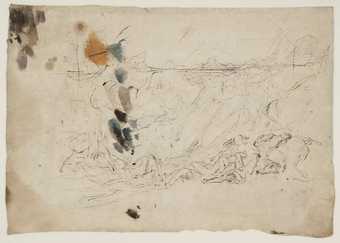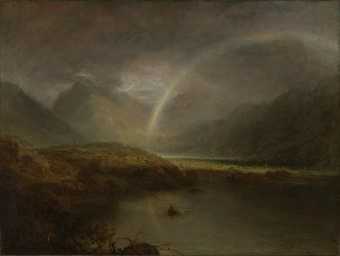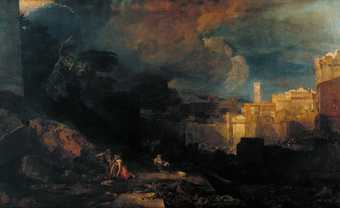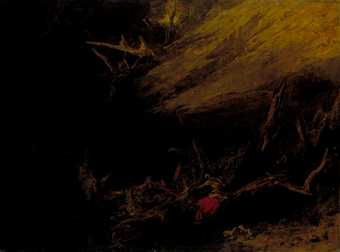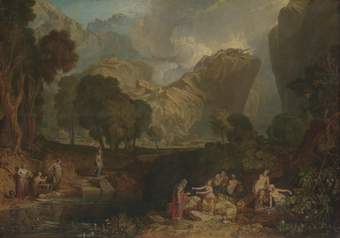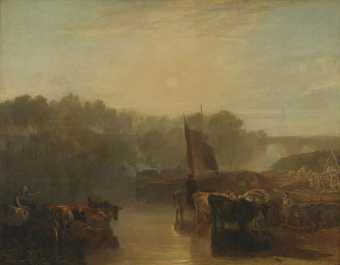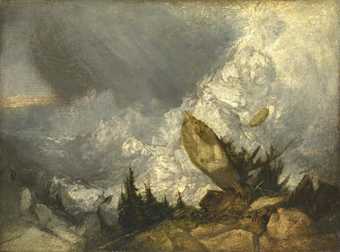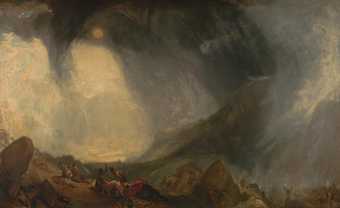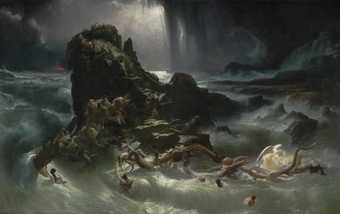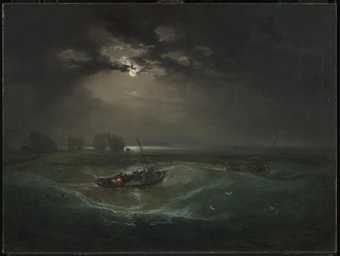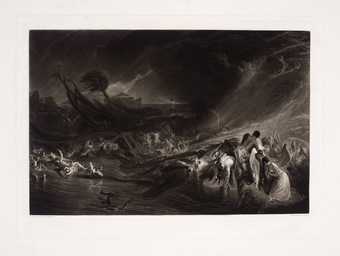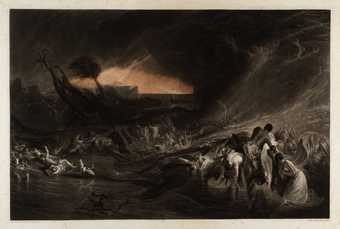
In Tate Britain
- Artist
- Joseph Mallord William Turner 1775–1851
- Medium
- Oil paint on canvas
- Dimensions
- Support: 1429 × 2356 mm
frame: 1800 × 2705 × 127 mm - Collection
- Tate
- Acquisition
- Accepted by the nation as part of the Turner Bequest 1856
- Reference
- N00493
Display caption
Gallery label, September 2004
Does this text contain inaccurate information or language that you feel we should improve or change? We would like to hear from you.
Catalogue entry
55. [N00493] The Deluge Exh. 1805?
THE TATE GALLERY, LONDON (493)
Canvas, 56 1/4 × 92 3/4 (143 × 235)
Coll. Turner Bequest 1856 (61, ‘The Deluge’ 7'10" × 4'10 1/2"); transferred to the Tate Gallery 1929.
Exh. ?Turner's gallery 1805; R.A. 1813 (213); Tate Gallery 1931 (23); R.A. 1974–5 (81); Paris 1983–4 (13, repr.).
Engr. By J.P. Quilley 1828 (perhaps significantly only two years after John Martin exhibited the first of his two large pictures of the subject); also, with considerable variations, by Turner or H. Dawe for the Liber Studiorum, R. 88, but not published (repr. Finberg 1924, p. 352; Turner's preliminary pen and sepia drawing from the Vaughan Bequest, CXVIII–X, is also repr. loc. cit.).
Lit. Farington Diary 21 February 1805; A. Pichot, Voyage historique et littéraire en Angleterre et en Ecosse, 1825, i, p. 188; Ruskin 1843 (1903–12, iii, p. 519); Thornbury 1862, i, p. 295; 1877, p. 431; Bell 1901, p. 93 no. 129; Armstrong 1902, p. 220; Finberg 1924, p. 353; Whitley 1928, pp. 88, 210–11; Davies 1946, p. 187; Finberg 1961, pp. 113, 117–18, 171, 195–6, 304, 475 no. 184, 512 no. 94a; Ziff 1963, p. 320, pl. 47; Lindsay 1966, pp. 87, 230 n. 9; Reynolds 1969, p. 61; Wilton 1980, pp. 136–9; Ziff 1980, p. 168; Verdi 1981, pp. 397–9, pl. 5.
A note in the British Press for 8 May 1804 stated that ‘Mr. Turner is engaged upon a very large picture of the Deluge, which he intends for the exhibition next year’. By ‘the exhibition’ is probably meant that at the R.A., but, apparently owing to some dispute in the Academy Council, Henry Thomson told Farington on 21 February 1805 that ‘Turner will not exhibit at the Royal Academy but at his own house’. It is likely therefore that The Deluge, like The Shipwreck, was on view in Turner's own gallery from early May to the beginning of July 1805. J. P. Quilley's mezzotint was dedicated by Turner to the late John Joshua Proby, first Earl Carysfort, who is not known to have owned any works by Turner but whose name appears in a list of patrons in the ‘Academies’ sketchbook of c. 1804 (LXXXIV–67 verso) against an unnamed ‘Historical’ work priced at £‘300’; Wilton has therefore made the plausible suggestion that The Deluge was intended for him but for some reason not purchased.
When exhibited again at the R.A. in 1813, the same year as Frosty Morning (No. 127, [N00492]), it must have looked rather conservative, but the Morning Chronicle for 3 May praised it as ‘a good composition, and treated with that severity of manner which was demanded by the awfulness of the subject’. The catalogue contained the following lines from Milton:
‘Meanwhile the south wind rose, and with black wings
Wide hovering, all the clouds together drove
From under heaven
the thicken'd sky
Like a dark cieling [sic] stood, down rush'd the rain
Impetuous, and continual, till the earth
No more was seen.’
(John Milton, Paradise Lost)
As in the case of his Plague pictures Turner may have been spurred on by the example of Poussin, whose own picture of the subject he had studied closely in the Louvre in 1802 (for his notes see the ‘Studies in the Louvre’ sketchbook, LXXII–41 verso, 42). The first French critic to note this work, A. Pichot, who saw it in Turner's gallery in 1825, compared it not however with Poussin but with the Scène de Deluge of 1808 by Girodet (Louvre). But Turner's main inspiration, particularly in the vivid colouring of the figures on the right, came from Titian and Veronese.
The drawing inscribed ‘Study for the Deluge’ in the ‘Calais Pier’ sketchbook shows an alternative composition, and that inscribed ‘Whirlwind’ is also related (LXXXI–120, 121, 163). The group of a man supporting a girl on the right is close to a figure study in the ‘Studies for Pictures’ sketchbook of c. 1800–02 (LXIX–66). Another drawing, CXX–X recto (repr. Wilton, op. cit., p. 136) and verso, does contain studies for this composition, while CXX-Y shows a group of figures struggling in the water.
This picture was priced at £300 in a note, probably of c. 1810, in Turner's ‘Finance’ sketchbook (CXXII–36; for the date see Nos. 53 and 56 [N00474]).
The back of the original canvas bears the inscription ‘JMWT 20’. The painting has suffered from extensive flaking and losses.
Published in:
Martin Butlin and Evelyn Joll, The Paintings of J.M.W. Turner, revised ed., New Haven and London 1984
Explore
- architecture(30,960)
- townscapes / man-made features(21,603)
-
- building - non-specific(3,161)
- universal concepts(6,387)
-
- destruction(383)
- vessels and containers(2,157)
-
- urn(52)
- drowned(55)
- black(796)
- crowd(646)
- Bible: Old Testament(381)
-
- Flood(23)
- birth to death(1,472)
-
- death(685)
You might like
-
Joseph Mallord William Turner The Deluge
date not known -
Joseph Mallord William Turner The Deluge
c.1815 -
Joseph Mallord William Turner Study for ‘The Deluge’
c.1804 -
Joseph Mallord William Turner Study for ‘The Deluge’
date not known -
Joseph Mallord William Turner Buttermere Lake, with Part of Cromackwater, Cumberland, a Shower
exhibited 1798 -
Joseph Mallord William Turner The Tenth Plague of Egypt
exhibited 1802 -
Joseph Mallord William Turner Jason
exhibited 1802 -
Joseph Mallord William Turner The Goddess of Discord Choosing the Apple of Contention in the Garden of the Hesperides
exhibited 1806 -
Joseph Mallord William Turner Abingdon
exhibited 1806? -
Joseph Mallord William Turner The Fall of an Avalanche in the Grisons
exhibited 1810 -
Joseph Mallord William Turner Snow Storm: Hannibal and his Army Crossing the Alps
exhibited 1812 -
Francis Danby The Deluge
exhibited 1840 -
Joseph Mallord William Turner Fishermen at Sea
exhibited 1796 -
After Joseph Mallord William Turner, engraver John P. Quilley The Deluge
1828 -
After Joseph Mallord William Turner The Deluge, engraved by J.P. Quilley
1828

